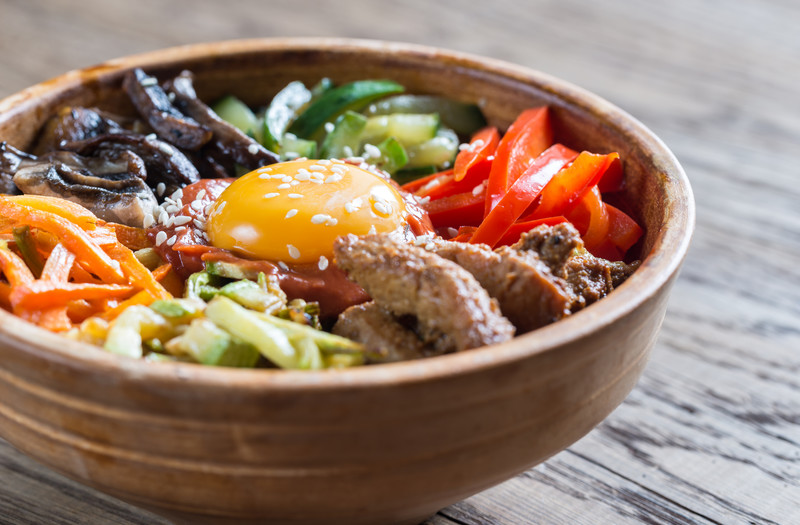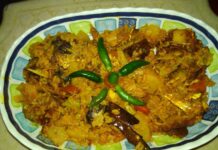Bibimbap- Korean Mixed Rice
Our food journeys have usually been focused either in India or typically looked west. Today I plan to look east, maybe not as far as the land of the rising sun, but just short. Us bongs have always been fans of Chinese food. But the new invasion is Korean. Whether it’s the drama of web series and movies or music in the form of K-pop today’s youth are looking at all things Korean. It is therefore no surprise that Korean food is also today pretty popular among the youth of today. So let us look at a Korean dish that’s easy, popular, and at the same time a riot of flavors. Our food journey today is with the Korean mixed rice, a wholesome meal in itself the Bibimbap.
The bibimbap is a dish that is not only tasty but has a history, culture, and very rich symbolism associated with it. The dish essentially is a mix of sauteed vegetables and meat mixed in a bowl of rice and topped with an egg and dollops of a spicy sauce. But the colors that are there in the dish symbolizes a region and part of the body. The red for example represents the south and the vegetables like red chili, carrots and dates represent the heart. East is represented by the greens like cucumber and spinach. This is for the liver. Nori seaweed, shiitake mushrooms, are black and stands for the kidney. The stomach and the center are represented by yellow, from pumpkins, egg, or potato. Lastly white is for the west and represents the lungs with radish and rice being the food components.
While the origins of the bibimbap are not known but they are associated with various rites the people practiced, particularly outdoors, such as dongsinje or the jesa for village gods. Similarly, sansinje the jesa for mountain gods was another outdoor rite. Crockery would be limited during these outdoor rites and hence to eat with the Gods, the essence of these rites, Baap or rice was mixed with banchan or side dishes giving rise to the bibimbap. An alternate view is that on the eve of the lunar year, it was felt auspicious to clear of all leftovers and hence mixed in a bowl with rice. Framers found this convenient to make during the farming season as well as economical both on the pocket and time. Royalty would have bibimbap resplendent in the variety of proteins and the exotic nature of the vegetables. The first known recipe is recorded in an anonymous cookbook of the 19th century The Siuijeonseo believed to be from a lady of sangju area. Bibimbap today is a strong representation of Korean culture because of the popularity of the dish.
Enough of the story of bibimbap, beyond mentioning that the name literally means mixed rice. The name is derived from bibim meaning to mix and bap that is rice so bibimbap is served as a bowl of white rice at room temperature with a dollop of bibimbap sauce and with slices of meat and a raw or fried egg with it. This is then mixed and eaten. The key ingredients of making bibimbap will thus be the rice, the meat, the sauteed vegetable, and the bibimbap sauce. We will address each of these individually.

Making Bibimbap sauce.
The key ingredient of the bibimbap is the sauce, whose key is the spicy red chilly/pepper paste Gochujang. A traditional gochujang bibimbap sauce that can work for 12 to 15 servings will have the following ingredients
- Toasted sesame oil ¼ cup
- Sugar ¼ cup
- Water ½ cup
- Toasted sesame seeds ¼ cup
- Minced garlic ¼ cup
- Vinegar 4 tsp
- Gochujang ½ cup
Gochujang can be purchased off the shelf or made at home though it involves a six-month fermentation period. However, the flavors you get by mixing the gochukaru or chili pepper powder, mejukaru or fermented soybean, sweet rice, rice syrup malt barley syrup, and salt in a hangari or glazed earthen pot as per your own tastes will make the gochujang your signature and, in the end, the bibimbap sauce that much delectable. This mixture is then fermented in the sun for4 to 6 months. Coming back to the bibimbap sauce, all the ingredients are mixed in a vessel and stirred and mixed evenly till a consistent mix is made. The water is progressively added so that it doesn’t become too runny. At the end of it, we should have a sweet and spicy sauce with a slightly pungent flavor. The content of the gochukaru is the determining factor in the spiciness of the sauce. If you are making the gochujang at home, only fine gochukaru powder or goun gochukaru is used and not gulkeun gochukaru or the coarse variant.
Meat and Meat Sauce
The ingredients for this is as follows
- Soy sauce 1 tbsp
- Sugar 1tsp
- Sesame oil 1 tbsp
- Minced garlic 4 large cloves to about ½ tsp
- Minced beef or strips 100 to 200 gms
Marinade the meat for 30 minutes in vinegar and garlic along with the soy sauce. To cook the meat, heat cooking oil in a wok to medium heat and cook the marinated beef in it for 3 to 5 minutes. Add sugar to taste and cook well in the open wok till the meat is well cooked. This is then set aside to cool and for use later
Vegetables and garnish
- Shiitake mushrooms 100 gms
- Carrots 1 medium about 150gms
- Sea salt finely ground ½ tsp
To Nori Seawood or seasonal seaweed shredded as per taste
- Bean sprouts up to 300 gms
- Spinach 250 gms
- Rice 3 portion serving
- Eggs 3 (as per rice serving portion)
- Cooking oil
Other vegetables like one cucumber sliced into juliennes or radishes similarly sliced into juliennes can also be used.
The spinach and beans sprouts are seasoned by blanching with a dash of salt and set aside. The carrot is then peeled and made into juliennes and then stir-fried in a wok on medium-high flame for 2 to 3 minutes mixed with about ¼ teaspoon of sea salt. This is also set aside. The shitake mushrooms are next washed and cut into thin slices on a high flame in an open wok this is again cooked for 2 to 3 minutes till well cooked and set aside. The remaining 1/4 teaspoon of sea salt is used while cooking the mushrooms The eggs are now cooked sunny side up and set aside. White rice is cooked and set aside.
Assembling the bibimbap.
This probably is the easiest bit of the cooking process. In a serving bowl place the rice. Add the meat in the meat sauce and the sauteed vegetables and mix. Now add the bibimbap sauce on the top letting it to trickle down. Set the sunny side up on top of this and you are ready to serve.
To enjoy the bibimbap, break the egg yolk and then mix the egg yolk and bibimbap sauce with the meat vegetables, and rice and then eat.
The meat we used was beef, however, any kind of protein, fin, feather, or fur can be used. Even tofu can be used and the bibimbap still tastes swell. Original versions also used raw eggs, allowing the egg to run in through the side of the bowl before mixing it and eating. The possibilities are immense. The nutritional value is also high as the rice would give a high carbohydrate content. The meat and egg would enrich the dish with high protein content. The vegetables would put in a high mineral and vitamin content. The spinach Iron, carrots Vitamin A, and so on. The entire food being cooked on medium heat and low oil content the nutritional value is retained. Thus bibimbap is a wholesome and comprehensive meal in itself. But since we are cooking a dish from a land unfamiliar to us I advise two ingredients from my mom’s kitchen that transcends cuisine and culture. A broad smile and a large helping of love for those who eat your suffering. I m sure the bibimbap will taste that much exotic, that much flavourful. Bon Appetit.






